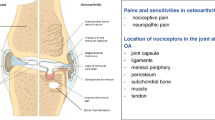Abstract
Studies of the nonpharmacologic treatment of osteo-arthritis (OA) have fallen behind that of pharmacologic therapy for a variety of reasons. The design of studies that involve a therapist-delivered physical intervention presents several problems with respect to patient and observer blinding, the beneficial effect of therapist contact alone, and separation of the effects of individual components of the "package" of delivered care. Important developments in the design and reporting of OA trials are discussed. Recent studies have demonstrated the modest but definite benefits of exercise therapy for OA of the knee, delivered either in hospital, primary care, or community settings. The reduction in pain and disability through an arthritis self-management group education program may extend to at least 1 year. Recent data that low intake of micronutrients (vitamins C, E, and D, and beta-carotene) may adversely influence the progression of knee OA and the incidence of hip OA suggest potential avenues for primary and secondary prevention of large joint OA.
Similar content being viewed by others
References and Recommended Reading
Schulz KF, Chalmers I, Hayes RJ, Altman DG: Empirical evidence of bias. JAMA 1995, 273:408–412.
Dieppe P: Osteoarthritis: time to shift the paradigm. BMJ 1999, 318:1299–1300.
O’Reilly SC, Muir KR, Doherty M: Knee pain and disability in the Nottingham community: association with poor health status and psychological distress. Br J Rheumatol 1998, 37:870–873.
Ettinger WH, Burns R, Messier SP, et al.: A randomised trial comparing aerobic exercise and resistance exercise with a health education program in older adults with knee osteoarthritis. JAMA 1997, 277:25–31. A randomized trial that examined the effect of aerobic or resistance exercise training in older patients with knee OA. There are modest improvements in measures of disability, physical performance, and pain from participating in either program.
Altman R, Brandt K, Hochberg M, et al.: Design and conduct of clinical trials in patients with osteoarthritis. Osteoarthritis Cartilage 1996, 4:217–243.
Group for the Respect of Ethics and Excellence in Science (GREES): osteoarthritis section: Recommendations for the reg-istration of drugs used in the treatment of osteoarthritis. Ann Rheum Dis 1996, 55:552–557.
Begg C, Cho M, Eastwood S, et al.: Improving the quality of reporting of randomised controlled trials. JAMA 1996, 276:637–639.
Van Baar ME, Dekker J, Oostendorp RAB, et al.: The effective-ness of exercise therapy in patients with osteoarthritis of the hip or knee: a randomised clinical trial. J Rheumatol 1998, 25:2432–2439. A randomized trial in primary care showing the effectiveness of exercise therapy for hip and knee OA. The effect size was medium with respect to pain reduction and small for disability reduction.
Cook RJ, Sackett DL: The number needed to treat: a clinically useful measure of treatment effect. BMJ 1995, 310:452–454.
O’Reilly SC, Muir K, Doherty M: Effectiveness of home exercise on pain and disability from osteoarthritis of the knee: a randomised controlled trial. Ann Rheum Dis 1999, 58:15–19. A program of home quadriceps exercises requiring minimal therapist intervention showing significant improvement in selfreported knee pain and function.
Hurley MV, Scott DL, Rees J, Newham DJ: Sensorimotor changes and functional performance in patients with knee osteoarthritis. Ann Rheum Dis 1997, 56:641–648.
Hurley MV, Scott DL: Improvements in quadriceps sensorimo-tor function and disability of patients with knee osteoarthri-tis following a clinically practicable exercise regime. Brit J Rheumatol 1998, 37:1181–1187. An outpatient-based exercise regime showing improvement in quadriceps strength, voluntary activation, knee position sense together with a reduced Lequesne Index and improved function. The improvements were maintained at 6 months review.
Sullivan T, Allegrante JP, Peterson MGE, et al.: One-year follow-up of patients with osteoarthritis of the knee who participated in a program of supervised fitness walking and supportive patient education. Arthritis Care Res 1998, 11:228–233.
Barlow JH, Turner AP, Wright CC: Long-term outcomes of an arthritis self-management programme. Brit J Rheumatol 1998, 37:1315–1319. A community-based education intervention showing improved ability to manage arthritis, reduced pain, and improved psychological well-being, which was sustained at 12 months.
Keefe FJ, Caldwell DS, Baucom D, et al.: Spouse-assisted coping skills training in the management of knee pain in osteoarthritis: long-term follow up results. Arthritis Care Res 1999, 12:101–111. Involvement of the spouse of the patient in coping skills training can enhance self-efficacy and improve the coping abilities of the patient for up to 12 months postintervention.
McAlindon TE, Felson DT, Zhang Y, et al.: Relation of dietary intake and serum levels of vitamin D to progression of osteoarthritis of the knee among participants in the Framingham Study. Ann Intern Med 1996:353–359. Low intake and serum levels of vitamin D both appear to associate with increased risk of progression of established knee OA but not with incidence of knee OA.
McAlindon TE, Jacques P, Zhang Y, et al.: Do antioxidant micronutrients protect against the development and progression of knee osteoarthritis? Arthritis Rheum 1996, 39(4):648–656.
Lane NE, Gore R, Cummings SR, et al.: Serum vitamin D levels and incident changes of radiographic hip osteo-arthritis. Arthritis Rheum 1999, 42(5):854–860. Low serum levels of 25 vitamin D may be associated with increased incidence of hip OA defined by joint space narrowing.
Felson DT, Zhang Y: An update on the epidemiology of knee and hip osteoarthritis with a view to prevention. Arthritis Rheum 1998, 41(8): 1343–1355.
Van Baar ME, Dekker J, Oostendorp RA, et al.: The effectiveness of exercise therapy in patients with osteoarthritis of the hip or knee: a randomized clinical trial. J Rheumatol 1998, 25(12):2432–2439.
Hurley, Scott: Quadriceps exercise for knee OA. Br J Rheumatol 1998, 77:1183.
Author information
Authors and Affiliations
Rights and permissions
About this article
Cite this article
Perkins, P.J., Doherty, M. Nonpharmacologic therapy of osteoarthritis. Curr Rheumatol Rep 1, 48–53 (1999). https://doi.org/10.1007/s11926-999-0025-1
Issue Date:
DOI: https://doi.org/10.1007/s11926-999-0025-1




